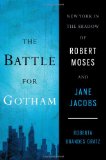The Battle for Gotham
Roberta Brandes Gratz, one of Planetizen’s Top 100 Urban Thinkers, explores what makes New York City work in her book The Battle for Gotham New York in the Shadow of Robert Moses and Jane Jacobs. With a title like you would assume the book dealt heavily with details of how Jacobs and Moses operated and their battles over urban renewal, but you would be wrong if you did. Instead, the bulk of the book deals with the last legacies of the policy and planning styles of Moses and the thinking of Jacobs. Despite being poorly titled, the book is an enjoyable read, at least until a number of editing errors mar the last third of the book.
The Battle for Gotham largely focuses on the author’s perspective of what makes New York City great, and what threatens that greatness. It’s clear that much of the author’s view on cities has been shaped by a personal friendship with the late, great urbanist Jane Jacobs. Gratz’s views are broken into chapters that deal individually with a New York City neighborhood or issue ranging from the regeneration of the predominantly cast-iron neighborhood SoHo to the battle to save industrial land in the city.
While much of the book deals with historical issues in the city (many of which ironically, given the title, fall after the time of Moses and Jacobs), including an extensive section on Westway and Jacobs views a former New Yorker on the proposed highway, the last part of the book deals with more current issues including Atlantic Yards, light rail, and the Park East Freeway.
When it comes to the Park East, as with many other areas later in the book (details below), her facts seem a bit distorted. She starts by discussing Norquist’s “Nordic look reflective of the immigrant history of that region,” which immediately makes me question her knowledge of the heavily German City of Milwaukee. On top of a few other fishy claims (the Lower East Side was reconnected to downtown after the freeway’s demolition?), she notes that “developers scrambled to build mixed-use buildings on a major portion of the reclaimed sixteen acres of city land”, which is arguably true, but misses the broader point that Milwaukee County’s land that is nearly four times that in size is almost entirely empty to this day. The Park East Freeway demolition was an improvement to the city, but not nearly like Gratz claims it was, which makes me question her other judgements in the city.
A number of other factual errors plague the end of the book (and leave me wondering what I missed earlier). Chelsea Market does not include a Whole Foods, let alone the first one in New York City (it’s located in Chelsea, but not in the redeveloped building she lauds). Who Framed Roger Rabbit? came out in 1988, not 1998 (a small error, until you consider all the other errors it piles on top of). Blair Kamin (not Kamen), is a male, not a female (she does correctly cite that he is the Chicago Tribune architecture critic). European cities, with few exceptions (London and Stockholm being the most notable), don’t have congestion pricing on the scale proposed in New York City.
Hopefully, a second edition (and possibly a retitling of the book) could correct many of these errors. Until then, I’m forced to wonder what factual inaccuracies I missed. Pile that on top of the lack of real depth on a number of issues, and this book could have been something, perhaps it would have been better off if the topic were narrowed. It’s a shame, because Gratz’s tales of neighborhood evolution were largely enjoyable until the numerous errors made me question everything I had read.
Final Rating – 2 out of 5 stars – Great potential, poor title, poor execution


















Nice work on this! You should be an editor!
@Reynaldo – Thank you!